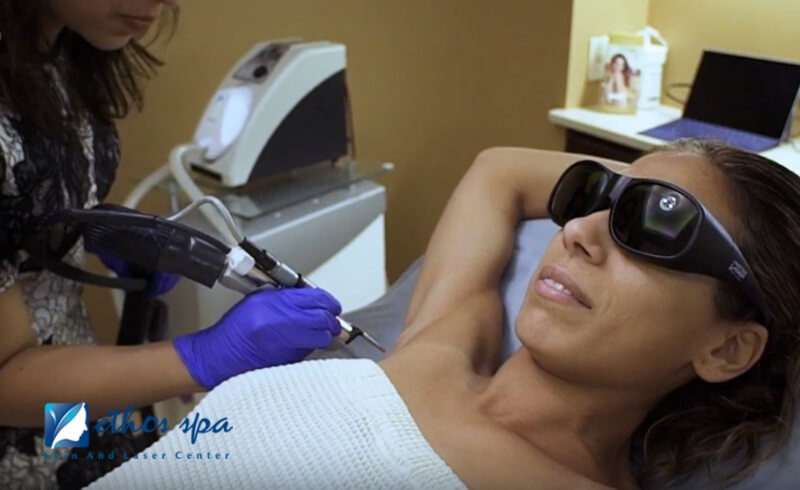Millions of people use laser technology for permanent hair removal solutions, and the industry only continues to grow annually.
But laser hair removal technology is relatively new, with the alexandrite laser only cleared for hair removal use by the FDA in 1997 (source).
So how was laser hair removal developed? While hair removal has existed in one form or another for as long as mankind has had hair, attempts at laser hair removal began in 1960s, soon after the invention of the first laser.
We’ll explore hair removal trends throughout history, the evolution of laser hair removal technology, and future advances in the laser hair removal industry.
Hair Removal Throughout History
The Egyptians and Sugaring: The Egyptians helped shape much of the modern world with countless innovations we still use today, one of which is the sugaring method of hair removal. It was thought back then that men with scruffy beards and women with body hair were uncivilized, so upper class Egyptians worked to keep their body hair at a minimum.
They used a variety of hair removal methods, including tweezers made from pumice stones and seashells; flint and bronze razors; and a kind of waxing technique known as body sugaring. Sugaring consists of ripping the hair at the root with a wax made out of lemon juice, water, and sugar.
The Persians and Threading: Also known as Bande Abru, threading was born 5000 years ago in Persia (or the Middle East). Threading involves tugging eyebrows with strands of thread, and is an effective hair removal process still used today. The technique is also known as khite, and was a popular treatment for women on their wedding day.
The Europeans and Walnut Oil: Queen Elizabeth I popularized the removal of eyebrows in 16th century Europe, giving the forehead a larger appearance. Interestingly enough, this was the only body hair they removed, letting the rest of their hair grow.
After shaving or waxing off the eyebrows, women would then rub certain substances on the forehead that prevented growth. These included walnut oil, bandages soaked in vinegar or ammonia, and in some cases, feline feces.
Modern Hair Removal: The first straight razor was invented by Jean Jacques Perret in 1760. It would be over a hundred years later when King Camp Gillette created the modern razor, first for men in 1880, and next for women in 1915.
The Evolution of Laser Hair Removal Technology

Theodore Maiman and the First Laser
The story of laser hair removal technology begins with a physicist by the name of Theodore Maiman, who would go on to be known as “the father of the electro-optics industry”.
Prior to Maiman’s invention of the laser in 1960, the underpinnings of laser technology had been theorized by Albert Einstein, and a device known as a maser (Microwave Amplification by Stimulated Emission of Radiation) had been available since 1953. Maiman wanted to extend the microwave capabilities of the maser to the optical range, with a device creating short wavelength light.
In 1960, Maiman invented the first laser and published his success in Nature. Colleagues at the time didn’t truly grasp the potential of laser technology, with one Irnee d’Haenens claiming that “A laser is a solution seeking a problem.” Maiman found so little support for finding a real-world application of the laser that he started two separate laser manufacturing companies in the 60s, Korad and Maiman Associates (source).
Maiman’s first laser was a ruby laser, and like most first-time inventions, it was a slow and inefficient version of what we would see decades later. Some researchers tested it on hair, and they found that while it could minimize hair growth, it also resulted in severe skin burns.
The YAG laser was invented and approved for hair removal by the FDA in 1964. It was found effective at reducing hair but it couldn’t create any permanent results. In the 70s, the alexandrite laser came on the scene. This laser was safer than its predecessors, but once again didn’t create the required heat to permanently end hair growth (source).
Dr. Richard Rox Anderson, the Laser Pioneer
Laser hair removal technology was stuck at an impasse for decades, with lasers being too ineffective of a treatment for long-term hair removal needs, and many scientists and doctors had given up on the idea.
Then came along Dr. Richard Rox Anderson, who would go on to achieve over 60 national and international laser-related patents. Anderson was working at the Harvard Medical School and had recently hired a new doctor for his team, Dr. Melanie Grossman.
Grossman suggested that they look into laser hair removal, citing the previous research into lasers and ineffective results. Anderson and Grossman started tests on hairy dogs, and in 1994 they released their first paper on laser hair removal on human subjects (source). Anderson was the first of their human trials, in accordance with his golden rule: “Do unto yourself before you do unto others.”
Anderson’s specific laser hair removal technique would go on to lay the foundation of modern laser hair removal as we know it today. A concentrated light beam is directed on the skin, which travels into the hair follicle.
The hair follicle becomes damaged by the intense light, preventing any future hair growth. While the process was generally similar to previous studies decades earlier, Anderson and Grossman had perfected the duration and intensity of the laser applied on the skin.
Because of Anderson and Grossman’s success with laser hair removal technology, the method was later approved by the FDA in 1997. Anderson would continue to conceive and develop many more laser treatments, including those for tattoo removal, pigmented lesions, birthmarks, and more (source).
Laser Hair Removal Technology Today and in the Future

Laser hair removal technology today is more sophisticated than ever before, with success rates going up to 95% permanent reduction of hair growth in most patients. Problems that were difficult before – such as treating patients with tanned skin and darker skin – are now solved with different kinds of lasers, such as diode laser technology.
These days there is also less risk of damage to the skin and surrounding hair follicles (due to shorter and more controlled laser pulse rates) and faster sessions. There are also various cooling technologies paired with laser hair removal, to make the experience as comfortable as possible.
There is also growing popularity and trust in at-home laser hair removal devices, with one company earning over $12 million in revenue over the last year (source). However, it should be noted that at-home devices have not been proven to offer the same levels of efficiency or long-term results that patients experience at professional clinics.
The Future of Laser Hair Removal
So what is in store for the future of laser hair removal technology? More efficiency, greater speed, and virtually no pain. While lasers haven’t changed much over the last two decades, there have been some small but important developments that affect the patient experience, including cooling systems, ability to help dark-skinned patients, and quicker procedures.
For example, one of the latest devices in the laser hair removal industry is the Splendor X by Lumenis. This device is the first laser that combines Nd:YAG and Alexandrite wavelengths, which work on two different fronts: the Alexandrite Wavelength is most effective for fair and light skin tones, and the Nd:YAG wavelength is best for tanned and dark skin tones (source).
They also target two different parts of the hair: the Alexandrite wavelength specializes in killing hair that sits on the skin’s surface, and the Nd:YAG wavelength targets the area beneath the top layer of the skin. This device is also less painful as it uses less energy than its predecessors.
Here are some areas where we may see improvements to laser hair removal technology in the future:
- Number of sessions: Right now, a patient may need an average of 4-8 treatments to completely remove all the hair in the targeted area. This means that each treatment can only remove around 15% or more of the area’s hair at the time, as this is how much will be in the “growth phase”. Moving forward, we may see laser hair removal technology that can destroy follicles of hairs that aren’t in the growth phase.
- At-Home devices: With the popularity of at-home laser hair removal devices growing, we can be sure to see more developments in the quality of these products. Perhaps within the next decade, they may be able to completely replicate the results of professional clinics today.
Laser Hair Removal at Ethos Spa
At My Ethos Spa, we specialize in only the latest and most advanced laser hair removal practices, giving our patients a world-class experience every time. Check out this testimonial from one of our happy clients:
For more information on laser hair removal and to schedule your first laser hair removal session, contact us today at Ethos Spa.







